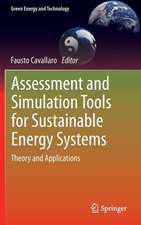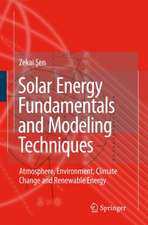BioH2 & BioCH4 Through Anaerobic Digestion: From Research to Full-scale Applications: Green Energy and Technology
Autor Bernardo Ruggeri, Tonia Tommasi, Sara Sanfilippoen Limba Engleză Paperback – 5 oct 2016
| Toate formatele și edițiile | Preț | Express |
|---|---|---|
| Paperback (1) | 637.59 lei 6-8 săpt. | |
| SPRINGER LONDON – 5 oct 2016 | 637.59 lei 6-8 săpt. | |
| Hardback (1) | 643.84 lei 6-8 săpt. | |
| SPRINGER LONDON – 10 mar 2015 | 643.84 lei 6-8 săpt. |
Din seria Green Energy and Technology
- 18%
 Preț: 943.43 lei
Preț: 943.43 lei - 20%
 Preț: 629.52 lei
Preț: 629.52 lei - 18%
 Preț: 1124.92 lei
Preț: 1124.92 lei - 18%
 Preț: 947.35 lei
Preț: 947.35 lei - 15%
 Preț: 655.92 lei
Preț: 655.92 lei - 18%
 Preț: 957.62 lei
Preț: 957.62 lei - 18%
 Preț: 789.52 lei
Preț: 789.52 lei - 17%
 Preț: 464.56 lei
Preț: 464.56 lei - 15%
 Preț: 645.79 lei
Preț: 645.79 lei - 18%
 Preț: 903.93 lei
Preț: 903.93 lei - 24%
 Preț: 1322.09 lei
Preț: 1322.09 lei - 18%
 Preț: 890.54 lei
Preț: 890.54 lei - 18%
 Preț: 1115.46 lei
Preț: 1115.46 lei - 18%
 Preț: 1117.03 lei
Preț: 1117.03 lei - 18%
 Preț: 949.73 lei
Preț: 949.73 lei - 18%
 Preț: 892.11 lei
Preț: 892.11 lei - 15%
 Preț: 648.24 lei
Preț: 648.24 lei - 18%
 Preț: 997.09 lei
Preț: 997.09 lei - 15%
 Preț: 579.81 lei
Preț: 579.81 lei - 18%
 Preț: 1123.15 lei
Preț: 1123.15 lei - 18%
 Preț: 961.41 lei
Preț: 961.41 lei - 17%
 Preț: 490.23 lei
Preț: 490.23 lei - 18%
 Preț: 904.60 lei
Preț: 904.60 lei - 15%
 Preț: 643.34 lei
Preț: 643.34 lei -
 Preț: 287.91 lei
Preț: 287.91 lei - 24%
 Preț: 634.05 lei
Preț: 634.05 lei -
 Preț: 379.40 lei
Preț: 379.40 lei - 18%
 Preț: 783.20 lei
Preț: 783.20 lei - 18%
 Preț: 1394.84 lei
Preț: 1394.84 lei - 18%
 Preț: 1691.57 lei
Preț: 1691.57 lei - 18%
 Preț: 1112.48 lei
Preț: 1112.48 lei - 15%
 Preț: 592.61 lei
Preț: 592.61 lei - 18%
 Preț: 952.09 lei
Preț: 952.09 lei - 18%
 Preț: 944.19 lei
Preț: 944.19 lei - 18%
 Preț: 891.33 lei
Preț: 891.33 lei - 18%
 Preț: 1252.44 lei
Preț: 1252.44 lei - 18%
 Preț: 789.52 lei
Preț: 789.52 lei - 20%
 Preț: 566.30 lei
Preț: 566.30 lei - 18%
 Preț: 1113.71 lei
Preț: 1113.71 lei - 18%
 Preț: 1114.24 lei
Preț: 1114.24 lei - 24%
 Preț: 590.60 lei
Preț: 590.60 lei - 20%
 Preț: 567.50 lei
Preț: 567.50 lei - 24%
 Preț: 907.50 lei
Preț: 907.50 lei - 18%
 Preț: 952.89 lei
Preț: 952.89 lei - 18%
 Preț: 952.89 lei
Preț: 952.89 lei - 18%
 Preț: 950.52 lei
Preț: 950.52 lei
Preț: 637.59 lei
Preț vechi: 750.11 lei
-15% Nou
Puncte Express: 956
Preț estimativ în valută:
122.01€ • 130.46$ • 101.72£
122.01€ • 130.46$ • 101.72£
Carte tipărită la comandă
Livrare economică 18 aprilie-02 mai
Preluare comenzi: 021 569.72.76
Specificații
ISBN-13: 9781447169833
ISBN-10: 1447169832
Pagini: 238
Ilustrații: XX, 218 p. 74 illus., 70 illus. in color.
Dimensiuni: 155 x 235 x 13 mm
Greutate: 0.34 kg
Ediția:Softcover reprint of the original 1st ed. 2015
Editura: SPRINGER LONDON
Colecția Springer
Seria Green Energy and Technology
Locul publicării:London, United Kingdom
ISBN-10: 1447169832
Pagini: 238
Ilustrații: XX, 218 p. 74 illus., 70 illus. in color.
Dimensiuni: 155 x 235 x 13 mm
Greutate: 0.34 kg
Ediția:Softcover reprint of the original 1st ed. 2015
Editura: SPRINGER LONDON
Colecția Springer
Seria Green Energy and Technology
Locul publicării:London, United Kingdom
Cuprins
Dark-h2 production ecological mechanisms by the mixed microbial community.- Pretreatment to increase hydrogen forming bacteria (hfb) physiological differences between h2-producing bacteria and h2-uptaking bacteria.- Kinetics and dynamics of h2 production.- Effect of temperature on fermentative h2 production.- Energy production of h2 in dark anaerobic fermentation.- Hydrogen production from bio-waste biomass as food for microorganisms.- Design criteria and scale-up procedure for h2 production.- Valorization of end-liquid products of h2 fermentation.- The technology of bioh2 plus bioch4.- Sustainability of the bioh2 plus bioch4 process.
Textul de pe ultima copertă
This book presents a Two-Stage Anaerobic Digestion (TSAD) technique for producing hydrogen and methane, following a step-by-step approach in order to guide readers through the experimental verification of the related hypothesis. In the first stage of AD, the reaction conditions are optimized to obtain the maximum amount of hydrogen, while in the second the liquid residue from the first phase is used as a substrate to produce fuel-methane. AD has traditionally been used to reduce the organic content of waste; this results in a biogas that is primarily constituted of CH4 and CO2. Over the last few decades, the conversion of organic matter into hydrogen by means of AD and selecting Hydrogen Producing Bacteria (HPB) has matured into a viable and sustainable technology among the pallet of H2 generation technologies. The combined bio-production of hydrogen and methane from Organic Waste Materials (OWM) is considered to be an ideal way of utilizing waste, and can increase energy efficiency (the substrate Heat Value converted into H2 and CH4 fuel) to roughly 80%, since the energy efficiency of H2-production alone (15%) is not energetically competitive. The two gas streams can be used either separately or in combination (Hytane®), be supplied as civilian gas or used for transportation purposes. All the aspects of this sustainable technology are taken into account, from the basic biochemical implications to engineering aspects, establishing the design criteria and the scale-up procedures for full-scale application. The sustainability of the TSAD method is assessed by applying EROI (Energy Return On Investment) and EPT (Energy Payback Time) criteria, and both the general approach and application to the field of Anaerobic Digestion are illustrated.
Caracteristici
Presents a new Anaerobic Digestion (AD) approach for producing hydrogen and methane in two subsequent stages and the transformation of traditional AD for producing biogases (methane and carbon dioxide) using organic materials such as energy crops or organic refuse obtained from the food chain Reviews the best results from the last decade on biohydrogen production by means of AD in order to understand how to proceed toward full-scale application Covers the analysis, design, and performance monitoring for a biohydrogen and biomethane production plant, focusing in particular on its energy sustainability with a novel engineering approach: EROI (energy return on investment) and EPT (energy payback time) Includes supplementary material: sn.pub/extras

























